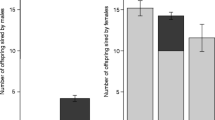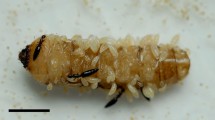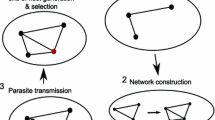Abstract
In the first part of the paper we analyse dynamics of the genetic mechanisms responsible for maintaining biased sex ratios in host-parasitoid interactions. We begin by reviewing recent results relating to the maintenance of sibmating in haplo-diploid populations. We then investigate the evolutionary stable sex ratio in populations in which all or some of the females mate with their brothers. In particular, we derive a diallelic one-locus model for studying evolutionary stable sex ratios in partially sibmating haplo-diploid populations. In the second part of the paper we review the impact of sex ratio on host-parasitoid populations. We then analyse how the sex ratio strategy of one parasitoid species may affect its interaction with another parasitoid species competing for the same host. In particular we show that, although a female biased sex ratio may enhance the inherent competitiveness of one species, it may also destabilize the ecological interaction of the three species so that all become extinct.
Similar content being viewed by others
Literature
Arditi, R. and H. R. Akçakaya. 1990. Underestimation of mutual interference of predators.Oecologia 83, 358–361.
Charnov, E. L. 1982.The Theory of Sex Allocation. Princeton, New Jersey: Princeton University Press.
Clark, A. B. 1978. Sex ratio and local resource competition in a prosimian primate.Science 201, 163–165.
Comins, H. N. and P. W. Wellings. 1985. Density-related parasitoid sex-ratio: influence on host-parasitoid dynamics.J. Anim. Ecol. 54, 583–603.
Feldman, M. W. and F. B. Christiansen. 1984. Population genetic theory of the cost of inbreeding.Am. Nat. 123, 642–653.
Fisher, R. A. 1930.The Genetical Theory of Natural Selection. Oxford, U.K.: Oxford University Press.
Fox, L. R. and D. K. Letourneau, J. Eisenbach and S. Van Nouhuys. 1990. Parasitism rates and sex ratios of a parasitoid wasp: effects of herbivore and plant quality.Oecologia 83, 414–419.
Getz, W. M. and V. Kaitala, 1989. Ecogenetic models, competition, and heteropatry.Theoret. Popul. Biol. 35, 34–58.
Getz, W. M., V. Kaitala and F. L. Ratnieks. 1992. Invasion dynamics and the evolutionary-stability of sibmating genes in diploid and haplodiploid populations. In review.
Hamilton, W. D. 1967. Extraordinary sex ratiosScience 156, 477–488.
Hassell, M. P. 1978.The Dynamics of Anthropod Predator-Prey Systems. Princeton, New Jersey: Princeton University Press.
Hassell, M. P. 1986. Parasitoids and population regulation. InInsect Parasitoids, J. Waage and D. Greathead (Eds), pp. 201–224. Orlando, Florida: Academic Press.
Hassell, M. P., J. Waage and R. May. 1983. Variable parasitoid sex ratios and their effect on host-parasitoid dynamics.J. Anim. Ecol. 52, 889–904.
Hogart, W. L. and P. Diamond. 1984. Interspecific competition in larvae between entomophagous parasitoids.Am. Nat. 124, 552–560.
Karlin, S. and S. Lessard. 1986.Sex Ratio Evolution. Princeton, New Jersey: Princeton University Press.
Mangel, M. and C. W. Clark. 1988.Dynamic Modeling in Behavioral Ecology. Princeton, New Jersey: Princeton University Press.
May, R. M. 1974. Biological populations with non-overlapping generations: stable points, stable cycles, and chaos.Science 186, 645–647.
May, R. M. and M. P. Hassell. 1981. The dynamics of multiparasitoid-host interactions.Am. Nat. 117, 234–261.
May, R. M., M. P. Hassell, R. M. Anderson and D. W. Tonkyn. 1981. Density-dependence in host-parasitoid models.J. Anim. Ecol. 50, 855–865.
Michod, R. E. and B. R. Levin. 1988.The Evolution of Sex. Sunderland, Massachusetts: Sinauer Associates.
Nicholson, A. J. and V. A. Bailey. 1935. The balance of animal populations.Proc. Zool. Soc. Lond., Part 1, 551–598.
Speirs, D. G., T. N. Sherratt and S. F. Hubbard. 1991. Parasitoid diets: does superparasitism pay?TREE 6(1), 22–25.
Taylor, P. D. and M. G. Bulmer. 1980. Local mate competition and the sex ratio.J. Theoret. Biol. 86, 409–419.
Uyenoyama, E. and B. O. Bengtsson. 1982. Towards a genetic theory for the evolution of the sex ratio: III. Parental and sibling control of brood investment ratio under partial sib-mating.Theoret. Popul. Biol. 22, 43–68.
Waage, J. 1986. Family planning in parasitoids: adaptive patterns of progeny and sex allocation. In:Insect Parasitoids, J. Waage and D. Greathead (Eds). London: Academic Press.
Author information
Authors and Affiliations
Rights and permissions
About this article
Cite this article
Kaitala, V., Getz, W.M. Sex ratio genetics and the competitiveness of parasitic wasps. Bltn Mathcal Biology 54, 295–311 (1992). https://doi.org/10.1007/BF02464835
Received:
Revised:
Issue Date:
DOI: https://doi.org/10.1007/BF02464835




